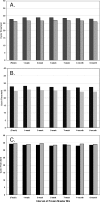Cost-effective modification of a commercial PCR assay for detection of methicillin-resistant or -susceptible Staphylococcus aureus in positive blood cultures
- PMID: 20147649
- PMCID: PMC2849536
- DOI: 10.1128/JCM.02463-09
Cost-effective modification of a commercial PCR assay for detection of methicillin-resistant or -susceptible Staphylococcus aureus in positive blood cultures
Abstract
Real-time detection of methicillin-resistant Staphylococcus aureus (MRSA) and methicillin-susceptible S. aureus (MSSA) in cases of clinical bacteremia may promote appropriate antimicrobial therapy and infection control. Expense inherent to molecular diagnostics may prevent laboratories from utilizing real-time PCR for this purpose. BD GeneOhm StaphSR assay master mix was reconstituted and aliquoted into SmartCycler tubes in 25-mul volumes (freshly reconstituted master mix), with a portion being frozen at -70 degrees C (frozen master mix). Incubation of 40 previously analyzed lysates from positive BacT/Alert SA and SN blood culture bottles (identified as 10 MRSA strains, 10 MSSA strains, 12 coagulase-negative Staphylococcus strains, and 8 Micrococcus strains) in freshly reconstituted master mix and master mix frozen between 1 week and 6 months generated the expected results in all PCRs. Similarly, positive- and negative-control reagents stored frozen at -70 degrees C for up to 18 weeks yielded the expected reactions. Prospective analysis of 244 positive blood culture samples utilizing 1-week-frozen master mix and freshly reconstituted master mix yielded a 1.2% discordant rate upon initial testing due to three unresolved results (two unresolved results for freshly reconstituted master mix and one unresolved result for frozen master mix). Repeat testing produced a final 100% concordance rate between the two master mix preparations. Use of master mix that was frozen up to 6 months did not compromise performance of the BD GeneOhm StaphSR assay. This modification, resulting in less reagent waste, may allow a greater number of laboratories to consider real-time PCR methodology for detection of bacteremia caused by MRSA and MSSA.
Figures

References
-
- Chang, F. Y., J. E. Peacock, Jr., D. M. Musher, P. Triplett, B. D. MacDonald, J. M. Mylotte, A. O'Donnell, M. M. Wagener, and V. L. Yu. 2003. Staphylococcus aureus bacteremia: recurrence and the impact of antibiotic treatment in a prospective multicenter study. Medicine (Baltimore) 82:333-339. - PubMed
-
- Cosgrove, S. E., and V. G. Fowler, Jr. 2008. Management of methicillin-resistant Staphylococcus aureus bacteremia. Clin. Infect. Dis. 46(Suppl. 5):S386-S393. - PubMed
-
- Cosgrove, S. E., Y. Qi, K. S. Kaye, S. Harbarth, A. W. Karchmer, and Y. Carmeli. 2005. The impact of methicillin resistance in Staphylococcus aureus bacteremia on patient outcomes: mortality, length of stay, and hospital charges. Infect. Control Hosp. Epidemiol. 26:166-174. - PubMed
-
- Cosgrove, S. E., G. Sakoulas, E. N. Perencevich, M. J. Schwaber, A. W. Karchmer, and Y. Carmeli. 2003. Comparison of mortality associated with methicillin-resistant and methicillin-susceptible Staphylococcus aureus bacteremia: a meta-analysis. Clin. Infect. Dis. 36:53-59. - PubMed
MeSH terms
LinkOut - more resources
Full Text Sources
Medical

